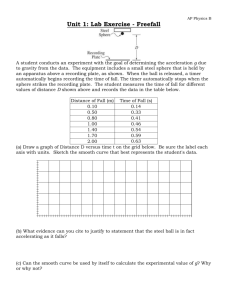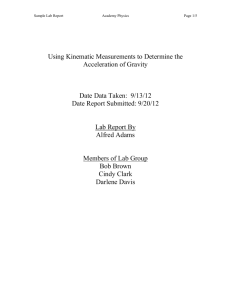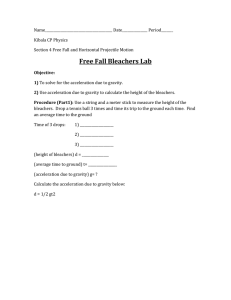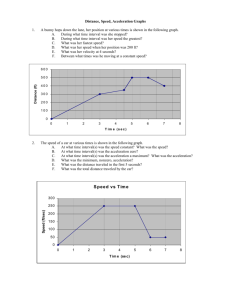Free Fall Acceleration Lab In this lab, we will experimentally
advertisement
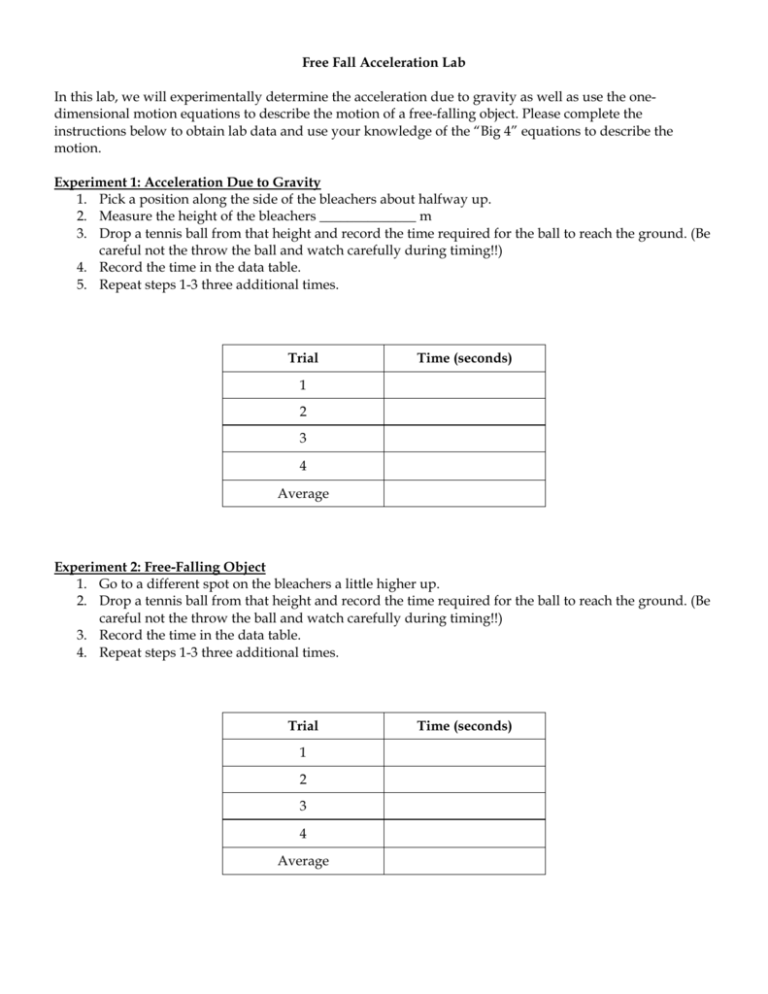
Free Fall Acceleration Lab In this lab, we will experimentally determine the acceleration due to gravity as well as use the onedimensional motion equations to describe the motion of a free-falling object. Please complete the instructions below to obtain lab data and use your knowledge of the “Big 4” equations to describe the motion. Experiment 1: Acceleration Due to Gravity 1. Pick a position along the side of the bleachers about halfway up. 2. Measure the height of the bleachers ______________ m 3. Drop a tennis ball from that height and record the time required for the ball to reach the ground. (Be careful not the throw the ball and watch carefully during timing!!) 4. Record the time in the data table. 5. Repeat steps 1-3 three additional times. Trial Time (seconds) 1 2 3 4 Average Experiment 2: Free-Falling Object 1. Go to a different spot on the bleachers a little higher up. 2. Drop a tennis ball from that height and record the time required for the ball to reach the ground. (Be careful not the throw the ball and watch carefully during timing!!) 3. Record the time in the data table. 4. Repeat steps 1-3 three additional times. Trial 1 2 3 4 Average Time (seconds) Experiment 3: Object Thrown Upward 1. Move to a location to the side of the bleachers (off of the bleachers) in an open area. 2. Toss the ball straight upward in the air and record the time required to reach its peak height. (Do not throw the ball to the moon and try to keep it straight!!) 3. Record the time in the data table. 4. Repeat steps 1-3 three additional times. Trial Time (seconds) 1 2 3 4 Average Calculations – Complete the following calculations as part of your lab report. Use the “Big 4” Equations and SHOW ALL WORK AND UNITS!!! In the first experiment, use the data collected and the height of the bleachers to experimentally determine the acceleration due to gravity (a) in m/s2. Recall that the actual value is 9.80 m/s2. o Calculate the percent error: exp erimental actual 100 actual In the second experiment, determine o The height (y) of the bleachers o The velocity (Vf) with which the ball strikes the ground. Use the actual value for acceleration due to gravity in your calculation. In the third experiment, determine o The maximum height (y) of the ball o The initial velocity (Vi) with which you threw the ball. o How long (s) it would take the ball to hit the ground once it reaches its highest point o The velocity (Vf) it would hit the ground with when it returns Lab Report – This should be typed and neatly organized. The report should have section headings for each section and include all of the following: 1. Purpose – One or two sentences describing what we were trying to do in the lab 2. Materials – a list of required materials needed to complete the lab 3. Procedure – a brief list of steps needed to complete the lab 4. Data – include your data tables from the lab 5. Calculations – see above 6. Analysis Questions a. How did the experimental acceleration due to gravity compare to the actual acceleration due to gravity? Explain any differences. b. Name and describe at least 3 errors and describe their effect on your results. c. What improvements would you do if you repeated this experiment? 7. Conclusion – Restate the results of each section and explain how this experiment and these equations apply to real-life.



